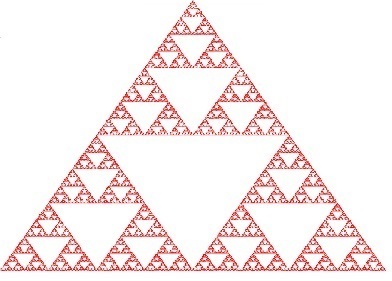Sierpinski's Triangle - 4

This problem is part of a set of problems, please see the linked first problem , if you haven't yet.
Question: What is the area of the white triangles in Sierpinski's triangle after an infinite number of steps?
Hints:
- Sierpinski's Triangle has a total area of 1.
Note: This problem is part of a set of problems, further investigating Sierpinski's Triangle in different ways. If you want to continue investigating click here . Questions will increase in difficulty.
Image Credits: Sierpinski's Triangle Image created by William Andrus. Removed grey outline.
This section requires Javascript.
You are seeing this because something didn't load right. We suggest you, (a) try
refreshing the page, (b) enabling javascript if it is disabled on your browser and,
finally, (c)
loading the
non-javascript version of this page
. We're sorry about the hassle.
After the first stage, the white triangle takes up 4 1 of the total figure, and the red triangles take up 4 3 of it.
After the second stage, the new white triangles take up 4 1 of the old red triangles, which took up 4 3 of the total figure, so they take up 4 1 ⋅ 4 3 of the total figure. Similarly, the red triangles now take up ( 4 3 ) 2 of the total figure.
After this, it should be clear that this pattern persists. At the n th stage, the new white triangles take up 4 1 ⋅ ( 4 3 ) n − 1 of the total figure, and the red triangles take up ( 4 3 ) n of the total figure.
This actually gives us two different ways to think about the area of the white triangles:
Because the total area is 1, however much of the total area the white triangles take up (as n → ∞ ) is just their area
Similarly, we can subtract how much the red triangles will take up (as n → ∞ ) from the total area (which is 1) to find the area of the white triangles
Method 1: Adding up the area of the new white triangles at each stage and taking the limit gives l i m n → ∞ ∑ k = 1 n 4 1 ( 4 3 ) k − 1 = ∑ k = 1 ∞ 4 1 ( 4 3 ) k − 1 = 4 1 ∑ k = 1 ∞ ( 4 3 ) k − 1 = 4 1 ∑ k = 0 ∞ ( 4 3 ) k = 4 1 ⋅ 1 − 4 3 1 = 4 1 ⋅ 4 1 1 = 4 1 ⋅ 1 4 = 1
Method 2: Taking the limit of the area of the red triangles gives l i m n → ∞ ( 4 3 ) n = 0 Obviously, 1 − 0 = 1